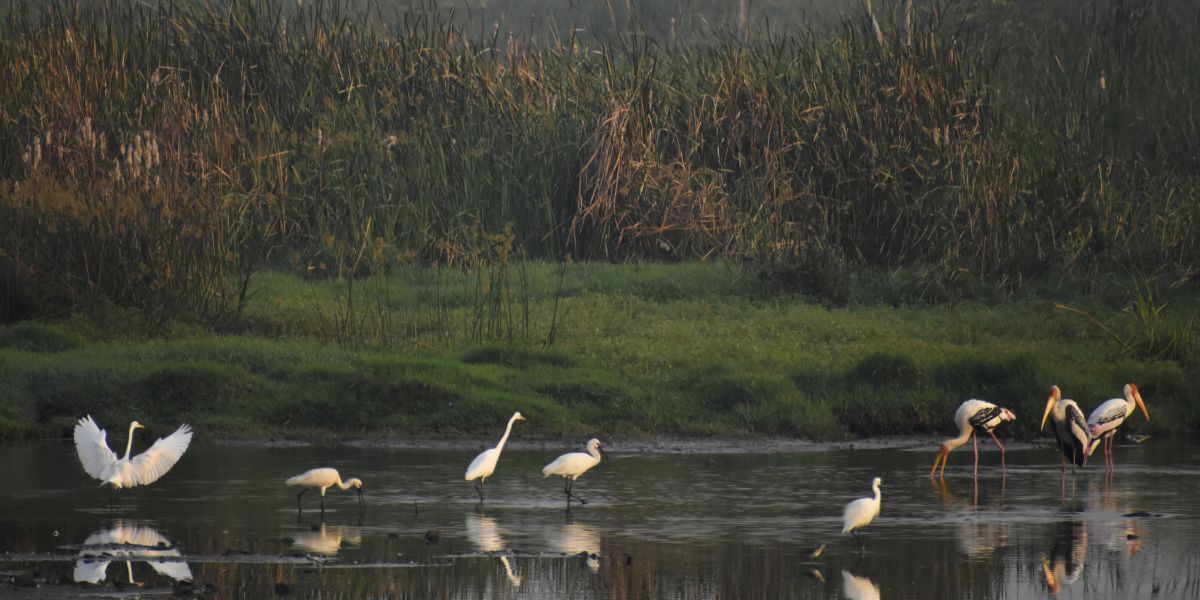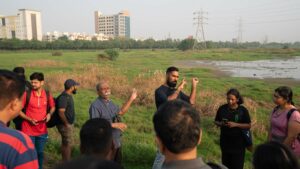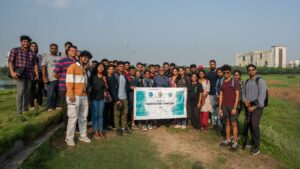The Margazhi Birds Thiruvizha at Pallikaranai marshland celebrated biodiversity and advocated for its preservation for a sustainable future.

Margazhi Birds Thiruvizha was curated by Care Earth Trust and Madras Photo Bloggers. (Mukesh Palaniappan)
The symphony of camera shutters clicking and the melodious chirping of winged visitors, harmonised with a medley of other nature sounds, enveloped me as I stepped into the tranquil Pallikaranai Marshland Park situated along the Velachery-Tambaram Main Road.
“As we near the end of winter, the number of birds here may dwindle. However, during the onset of the migratory season, around September, you’ll witness an abundance. There — can you spot the Northern Pintail?” inquires Vasanthy Shrikanth, a wildlife photographer.
As a novice birdwatcher armed with no zooming equipment, I relied on the inherent 576 megapixels of my eyes to keenly observe and absorb the unique characteristics of these winged wonders.
On Saturday, 20 January, 2024, I was at the Margazhi Birds Thiruvizha, an inclusive photo walk at Pallikaranai Marshland. The event was curated by Madras Photo Bloggers and Care Earth Trust, in collaboration with the Tamil Nadu Forest Department and the Conservation Authority of Pallikaranai Marshland. The walk garnered the enthusiasm of over 70 avid birders and bird photographers.

Ranjith Daniels (Left), Srivatsan Sankaran (Right). (Supplied)
The diverse assembly included a sign interpreter, rendering the walk accessible for individuals from the deaf community.
Purple swamp hens gracefully strolled through the marsh while flicking their tails up and down, a pied kingfisher deftly caught and devoured a fish, and a fleeting glimpse of the red-wattled lapwing. These were our sights during our two-hour stroll along the 2 km-long walking trail within the ecological park. We were delighted to spot over 20 bird species thriving in this vibrant ecosystem.
As we absorbed the sight of various other species, such as the grey-headed lapwing from Mongolia, Whistling Teal, Painted Storks, Spot-billed Pelicans, Cormorants, Darters, Black-headed Ibises, Caspian Tern, Sandpipers, Grey Heron, and Ruff, and the majestic Great Egret, Ranjith Daniels RJ, ornithologist and trustee of Care Earth Trust, directed our attention to an urgent matter.
“This area is likely the last natural urban wetland in the city,” he said.

The walk garnered the enthusiasm of over 40 avid birders and bird photographers. (Supplied)
Unlike coastal wetlands such as Pulicat and Kazhuveli, which consist mainly of brackish water, Pallikaranai features a unique combination of freshwater and brackish water, resulting in a diverse habitat.
“The area has preserved its marshy characteristics, and any transition to a completely freshwater environment could pose dangers,” he shared.
Functioning as a buffer zone in the flood-prone city, this extensive marsh spans about 600 hectares. Due to external manipulation of the wetland, it has been divided into segments; however, in its original state, it was a continuous stretch.
“The current, accessible portion is considered better in terms of ecological health. As one moves further north, the condition deteriorates, and the southern part faces similar challenges. Garbage dumping has become a prevalent issue, leading to pollution entering the water,” he shared.
Another notable concern is the invasion of the hazardous plant, Prosopis juliflora known as Veli Kathan or Seemai Karuvelam Maram, native to Mexico.
“The Forest Department is actively working to prevent and eliminate the presence of this invasive species, ensuring the protection of the natural integrity of the area,” he noted.
Pallikaranai is situated within the Central Asian Flyway. It is a significant migratory route that lures birds from Eurasia during their winter migration.
This southward journey from the northern climates typically commences around September.
“Thirty per cent of Chennai’s bird species are migratory. A majority of these are wetland birds. So, the area becomes a crucial haven for these avian travellers,” he explained.
Since 2002, the region has been meticulously documented, leading to the identification of over 180 bird species of birds.

“On any given day, the area reveals a diverse array of 25-30 species, occasionally even reaching up to 100 to 150,” he noted.
Against the backdrop of Daniel’s depiction of the wetland, frequent visitors to the marshland expressed their concerns that it has deteriorated over the years due to encroachments and garbage dumping. One participant remarked, “Plots are being sold, and housewarming ceremonies are being conducted every day.”
Originally designated as wasteland, an effort to protect the wetland led to the state declaring over 700 acres of the marsh as a reserve forest in 2007.
“In a notable recognition of its global importance, Pallikaranai achieved the honour of being nominated as a Ramsar site in 2022. Tamil Nadu boasts a total of 14 Ramsar sites, and Pallikaranai stands proudly among them,” highlighted Daniel.
Srivatsan Sankaran, founder of Madras Photo Bloggers, conveyed the significance to deaf participants through sign language.
Despite its international acknowledgement, the area is confronted with various threats and faces the potential loss of its Ramsar designation if swift measures aren’t implemented to counteract the pollution and misuse it experiences.
As an ecologically sensitive zone, it has been consistently under threat from pollution emanating from nearby industries, indiscriminate garbage dumping, and encroachments. Over time, its expanse has dwindled significantly from an initial area of over 5,000 hectares to a mere 600 hectares.
“These avian visitors travel from various corners of the world. Unfortunately, they have to forage on sewage and garbage before continuing their journey,” rued Daniels.
During their time here, they dedicate three to four months to accumulating crucial fat reserves. These are necessary for their flight back to find a mate, regenerate new feathers, construct nests, and engage in breeding.
“It is imperative to exercise caution. Their fatty bodies tend to accumulate toxins, including pesticides and heavy metals, posing a threat to their overall well-being. I have consistently stressed this point on multiple occasions. If we can prioritise our diaspora and NRIs, it’s equally essential to extend the same level of importance to our feathered friends, who travel all the way here,” he asserted.
During such photo walks, the act of capturing photographs and showcasing them to the public can play a pivotal role in disseminating awareness about these remarkable creatures, he noted, while the birders enthusiastically clicked away.
“It is imperative to assign importance to the conservation of both the land and birdlife,” added Daniels.
After the devastating Chennai floods in December 2023, which severely impacted Pallikaranai and its surrounding areas, the Tamil Nadu government revealed plans for a coastal restoration mission to be carried out over five years at a cost of ₹2000 crores.
After decades of anticipation for restoration, the uncertainty remains: will it materialise? Only time will reveal whether the land and its migratory guests can withstand the challenges of time and human indifference.

May 20, 2024

May 19, 2024

May 19, 2024

May 18, 2024

May 17, 2024

May 17, 2024